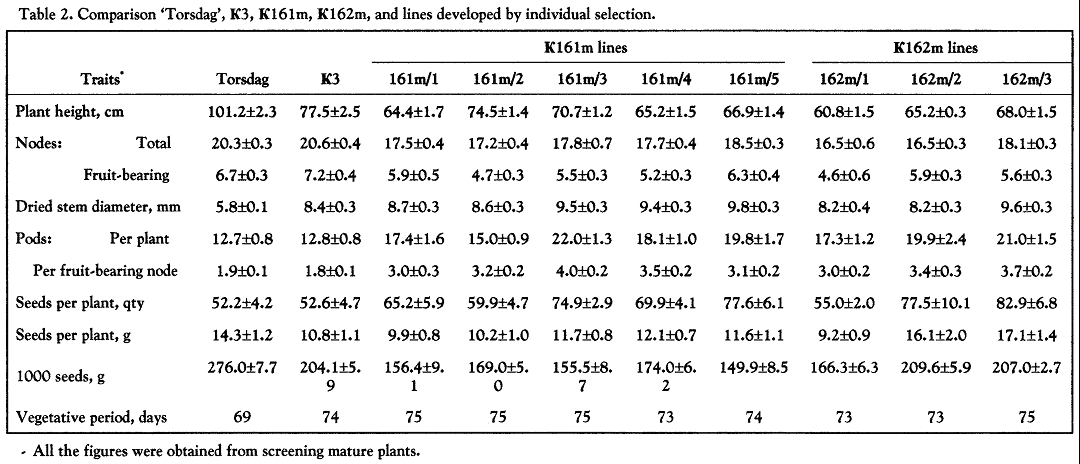
Inducing pea mutants by step mutagenesis
Sidorova, K.K., Shumny, V.K., Vlasova, E.Yu., Inst. of Cytology and Gen., Russian Acad. of Sci.
Glianenko, M.N. and Mishchenko, T.M. Novosibirsk, Russia
There are two ways in which induced mutants are used for the development of new cultivars. One is through identification of mutants that have direct agricultural value, their propagation and inclusion in ecological trials. Judging by the track record, this approach has been successful in many instances. Most induced mutants, however, have low viability and low fertility. Furthermore, positive and negative traits often co-exist in them, precluding direct use of these mutants as new cultivars. For these reasons breeders usually rely on a second method of taking advantage of mutations: that involving hybridization. For example, several peas cultivars have been developed in Poland using crosses to Wasata, a cultivar developed from a mutant line that does not develop leaflets (afila-type) [1]. We have developed a fodder cultivar Druzhnaya, by screening hybrids of a chlorophyll mutant К2004, previously derived from Torsdag, and Folenskaya 42, a fodder cultivar. Druzhnaya is noted for its rapid growth and accumulation of green matter at the onset of flowering, simultaneous seed maturation, and enhanced resistance to pests, diseases and adverse environmental factors (drought, frost). The green matter and grain productivity is high. The goal of the present experiment was to improve the significance of mutants to breeding programs by means of step mutagenesis.
The erectoid mutant, К3, was induced by exposure of Torsdag seeds to 0.02 % EI. Unlike Torsdag, К3 has an erect stem, shortened internodes, and improved lodging resistance. Seed production is similar to that in Torsdag, except for a lower seed weight per plant, resulting from the smaller seeds of К3. In order to improve the productivity of the mutant plants, we wanted to generate mutants from the К 3 line with erect stems and a better seed production. М10 К3 seeds were exposed to 0.15 % EMS. Two phenotypes were identified in М2 plants, К161m and К162m, that possessed erectoid stem and an increased number of pods on the fruit-bearing stem. Inheritance of these mutant traits was investigated by examination of F2 populations derived from crosses between parent and mutant or between mutants (Table 1). Segregation in the F2 hybrids suggests that the unique phenotypes in К3 and К162m are due to recessive monogenic mutations. When looking at the F2 161m x К3 progeny, we observed a 9:7 dihybrid segregation due to a complementary effect of the genes (Table 1).
Table 1. Segregation in F2 progeny of К3 x Torsdag, К161m x К3, and К162m x К3.
|
Hybrid |
F1 |
Segregation in F2 progeny |
c2 |
P |
|
К3 х Torsdag |
Torsdag type |
146 : 40 |
1.21 3 : 1 |
0.27 |
|
К162m х К3 |
К3 type |
78 : 14 |
0.50 3 : 1 |
0.48 |
|
К161m х К3 |
К3 type |
55 : 39 |
0.20 9 : 7 |
0.66 |
The 161m and 162m M4 mutant lines were screened, on a per plant basis, for the most productive plants, and eight new lines were derived. Assessment of these lines with respect to productivity is presented in Table 2. The trial was run under field conditions.

The main mutant trait—the erect aspect of the stem—was more obvious in the К161m/1 – К161m/5 and К162m/1 –К162m/3 lines than in К3. The plants were shorter, the stem diameter greater. A higher number of pods and seeds per plant, was observed in all lines compared to the original parents, Torsdag and К3. Judging by the weight of 1000 seeds, the seed was smaller in the derived lines than in К3 or Torsdag. Nevertheless, many of the lines were superior to К3 with respect to the weight of seeds per plant. К162m/2 and К162m/3 are remarkable in that they were even superior to Torsdag in this respect. Overall, the results of our study suggest that step mutagenesis is appropriate for improving the breeding value of induced mutants.
1. Micke A. 1988. Improvement of grain legume production using induced mutations. IAEA, Vienna, pp 1-51.
2. Sidorova К.К. 1992. In: Shumny, V.К. and Sidorova, К.К. (eds.). Geneticheskiye metody v selektsii rasteniy (Genetic Methods in Plant Breeding Practice). Nauka, Novosibirsk, pp 43-62 (in Russian).